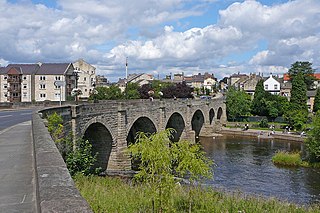
Wetherby is a market town and civil parish within the City of Leeds metropolitan borough, in West Yorkshire, England, close to the county's border with North Yorkshire and lies approximately 12 miles from Leeds City Centre, 12 mi (19 km) from York and 8 mi (13 km) from Harrogate. The town stands on the River Wharfe, and for centuries has been a crossing place and staging post on the Great North Road midway between London and Edinburgh.

Knaresborough is a market and spa town and civil parish in the Borough of Harrogate, North Yorkshire, England, on the River Nidd 3 miles (4.8 km) east of Harrogate.

Seacroft is an outer-city suburb/township consisting mainly of council estate housing covering an extensive area of east Leeds, West Yorkshire, England. It lies in the LS14 Leeds postcode area, around 4 miles (6.4 km) east of Leeds city centre.

Linton is a village 1.5 miles (2.4 km) south-west of Wetherby in West Yorkshire, England, in the parish of Collingham and the City of Leeds metropolitan borough. At the 2011 Census the village fell within the Harewood ward of the City of Leeds Council. It lies between Wetherby and Sicklinghall, on the north bank of the River Wharfe, opposite Collingham on the south bank.

Barwick-in-Elmet is a village in West Yorkshire, 7 miles (11 km) east of Leeds city centre. It is one of only three places in the area to be explicitly associated with the ancient Romano-British kingdom of Elmet, the others being Scholes-in-Elmet and Sherburn-in-Elmet.
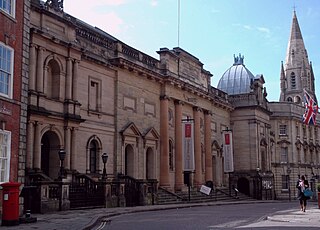
The National Justice Museum is an independent museum on High Pavement in the Lace Market area of Nottingham, England.
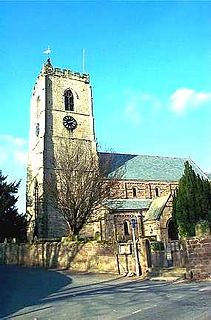
Spofforth is a village in the civil parish of Spofforth with Stockeld in the Harrogate district of North Yorkshire, England, about 3 miles (4.8 km) north west of Wetherby and 5 miles (8 km) south of Harrogate on the River Crimple, a tributary of the River Nidd.

The architecture of Aylesbury, the county town of Buckinghamshire, reflects that which can be found in many small towns the length and breadth of England. The architecture contained in many of the country's great cities is well recorded and documented, as is that of the numerous great country houses. Frequently the work is by one of England's more notable architects – Christopher Wren, John Vanbrugh, Robert Adam, William Kent or even Quinlan Terry. What is less well known is the local almost vernacular architecture in the market towns, often inspired by the work of the great master architects or the general architectural style popular at the time. England had a middle class long before many other European countries, these bourgeois merchants would often return from a visit to one of the cities, or having seen a glimpse of one of the great country houses then require a replica of what they had seen. A local architect would then be employed to recreate it, within limited financial restraints. Sometimes the patron would merely draw an image of what he required and a builder would then interpret the requirements to the best of his often limited ability.
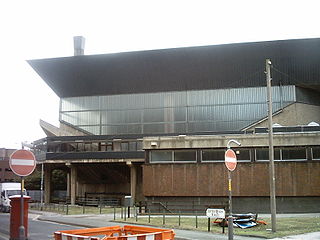
The Leeds International Pool often referred to as the Leeds International Baths, was a swimming facility in Leeds city centre, West Yorkshire, England. The pool was situated at the lower end of Westgate and was notable for its brutalist architecture. The pool was constructed in the 1960s and designed by architect John Poulson.
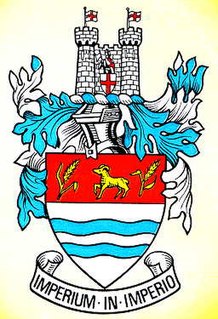
The recorded history of Wetherby, a market town in the City of Leeds metropolitan borough, West Yorkshire, England, began in the 12th and 13th centuries when the Knights Templar and later the Knights Hospitallers were granted land and properties in Yorkshire. The preceptory founded in 1217 was at Ribston Park. In 1240 the Knights Templar were granted by Royal Charter of Henry III the right to hold a market in Wetherby. The charter stated the market should be held on Thursdays and an annual fair was permitted lasting three days over the day of St James the Apostle.

St James' Parish Church is an Anglican parish church serving the parish of Wetherby with Linton in Wetherby, West Yorkshire, England.

The Golden Triangle is a term commonly used by estate agents for the area of West and North Yorkshire lying between Harrogate, York and North Leeds. Lying in the centre of this area is Wetherby on the fringes of West Yorkshire. Despite mainly being an affluent area the area does consist of some deprived areas such as Swarcliffe, Cranmer Bank and Hallfields. The most expensive street in the golden triangle is Fulwith Mill Lane on the South Side of Harrogate, where the average house price is £1.7 million.

Wetherby railway station was built on the North Eastern Railway's Cross Gates to Wetherby Line on Linton Road. It replaced an earlier station on York Road which had opened on 1 May 1876.

Wetherby railway station was first built on the York and North Midland Railway Company's Harrogate to Church Fenton Line and the station was situated on York Road. The Goods Shed remains and is situated off York Road in a small industrial estate and is a dance venue.

The Harrogate–Church Fenton line was a railway line opened by the York and North Midland Railway between 1847 and 1848 linking Harrogate and Church Fenton.

Wetherby Bridge is a scheduled monument and Grade II-listed bridge over the River Wharfe in Wetherby, West Yorkshire, dating from the 13th century. The bridge connects Micklethwaite on the south bank to the town centre on the north. It formerly carried the A1 Great North Road but now carries the A661 Boston Road leading to Boston Spa and the south.

Stratford-upon-Avon Guildhall is a municipal building in Church Street, Stratford-upon-Avon, Warwickshire, England. It is a Grade I listed building.
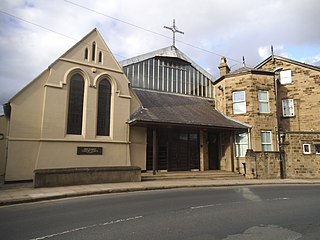
St Joseph's Church is an active Roman Catholic church in Wetherby, West Yorkshire, England.

Altrincham Town Hall is a municipal building in Market Street, Altrincham, Greater Manchester, England. The town hall was the headquarters of Altrincham Borough Council.

Wallingford Town Hall is a municipal building in the Market Place in Wallingford, Oxfordshire, England. The building, which is the meeting place of Wallingford Town Council, is a Grade I listed building.


























